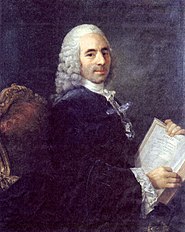| Part of a series on |
| Capitalism |
|---|
Physiocracy (French: physiocratie; from the Greek for "government of nature") is an economic theory developed by a group of 18th-century Age of Enlightenment French economists who believed that the wealth of nations derived solely from the value of "land agriculture" or "land development" and that agricultural products should be highly priced.[1] Their theories originated in France and were most popular during the second half of the 18th century. Physiocracy became one of the first well-developed theories of economics.[2]
François Quesnay (1694–1774), the marquis de Mirabeau (1715–1789) and Anne-Robert-Jacques Turgot (1727–1781) dominated the movement,[3] which immediately preceded the first modern school, classical economics, which began with the publication of Adam Smith's The Wealth of Nations in 1776.
The physiocrats made a significant contribution in their emphasis on productive work as the source of national wealth. This contrasted with earlier schools, in particular mercantilism, which often focused on the ruler's wealth, accumulation of gold, or the balance of trade. Whereas the mercantilist school of economics held that value in the products of society was created at the point of sale,[4] by the seller exchanging his products for more money than the products had "previously" been worth, the physiocratic school of economics was the first to see labor as the sole source of value. However, for the physiocrats, only agricultural labor created this value in the products of society.[4] All "industrial" and non-agricultural labors were "unproductive appendages" to agricultural labor.[4]
Quesnay was likely influenced by his medical training, particularly by the work of William Harvey who explained how blood flow and the circulatory system is vital to the human body; Quesnay held that the circulation of wealth was vital to the economy. Societies at the time were also overwhelmingly agrarian. This may be why they viewed agriculture as the primary source of a nation's wealth. This is an idea which Quesnay purported to demonstrate with data, comparing a workshop to a farm. He analyzed "how money flowed between the three classes of farmers, proprietors, and artisans, in the same mechanical way that blood flows between different organs" and claimed only the farm produced a surplus that added to the nation's wealth. Physiocrats viewed the production of goods and services as equivalent to the consumption of the agricultural surplus, since human or animal muscle provided the main source of power and all energy derived from the surplus from agricultural production. Profit in capitalist production was really only the "rent" obtained by the owner of the land on which the agricultural production took place.[4]
"The physiocrats damned cities for their artificiality and praised more natural styles of living. They celebrated farmers."[5] They called themselves les Économistes, but are generally referred to as "physiocrats" to distinguish their beliefs from the many schools of economic thought that followed.[6]
- ^ "physiocrat". Oxford Dictionaries. Oxford University Press. Archived from the original on July 4, 2014. Retrieved 27 October 2013.
- ^ Bertholet, Auguste; Kapossy, Béla (2023). La Physiocratie et la Suisse (in French). Geneva: Slatkine. ISBN 9782051029391.
- ^ Steiner (2003), pp. 61–62
- ^ a b c d Karl Marx and Frederick Engels (1988), pp. 348, 355, 358.
- ^ Why Americans Value Rural Life by David B. Danbom
- ^ The Penguin Dictionary of Economics, George Bannock, R. E. Baxter and Evan Davis. 5th Edition. Penguin Books 1992 p. 329.

